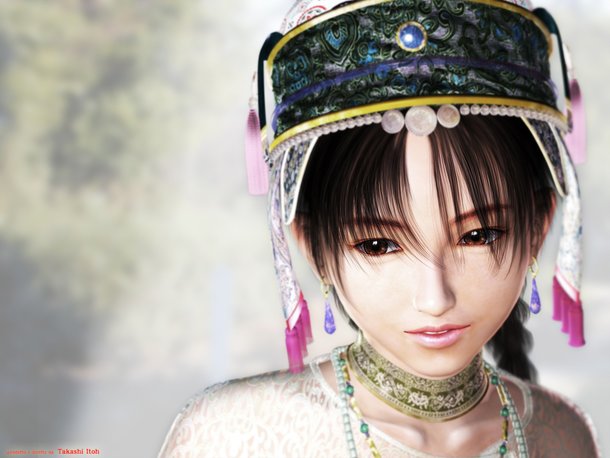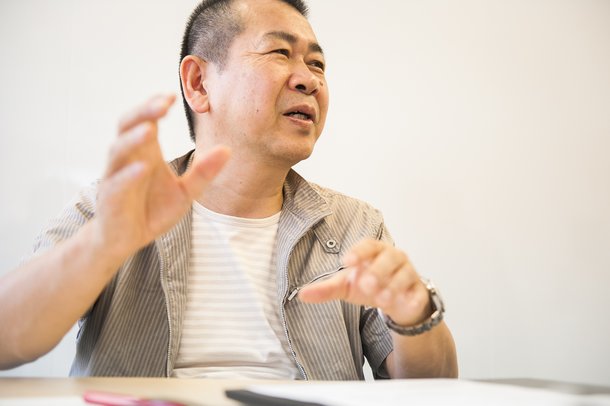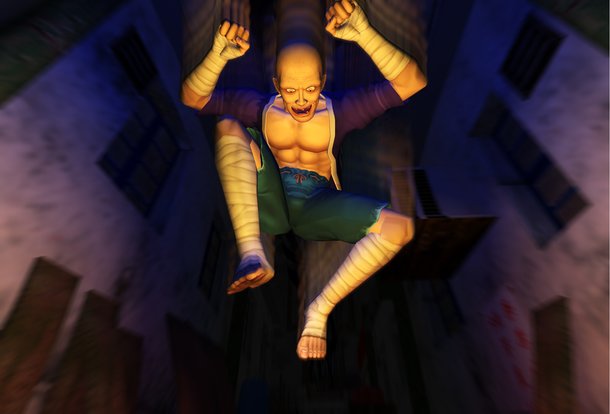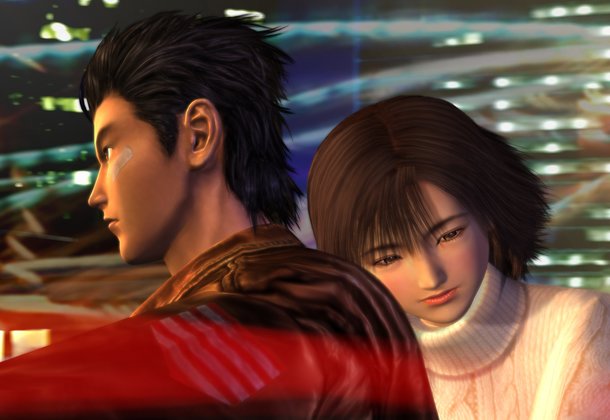After announcing the production of Shenmue 3 at this year’s E3 (Electronic Entertainment Expo), the biggest gaming event in the world held in Los Angeles in June, producer Yu Suzuki has succeeded in raising funds for the project through Kickstarter. As production is finally starting in earnest, we asked Suzuki about Shenmue 3 and his present state of mind.
Yu Suzuki’s Profile
Japanese game creator and game producer. His representative works include the arcade games Hang-On and the Virtua Fighter series. He first became involved in the making of home console games for the Sega Dreamcast. He released Shenmue in 1999 and Shenmue 2 in 2001, and even though it instantly rose to fame, the series remained unfinished. Breaking 14 years of silence, he announced the production of Shenmue 3 at E3 in June 2015. He used the crowdfunding service Kickstarter for fundraising and succeeded in doing so.
At E3, “they were cheering as if a deceased child just came back to life”
Tokyo Otaku Mode (TOM): It was a huge surprise when you broke 14 years of silence with the announcement on Shenmue 3 at E3. The mass of fans went wild with joy upon hearing the news. How did you feel about that situation?
Yu Suzuki (S): Before the announcement of Shenmue 3, I could hear the earth-shattering cheers when they announced big titles such as The Last Guardian and the remake version of Final Fantasy VII, so I was a bit worried if Shenmue would fit here. However, when the cheers for Shenmue rose, there was a noticeable difference in their pitch. Even my ears could hear the shrillness of those cheers.
TOM: As if their cries and roars reverberated throughout the hall.
S: Well, it might not be the best example, but for Final Fantasy VII, their excitement was similar to that of having won the lottery, while for Shenmue 3 they were cheering as if a deceased child just came back to life (laughs). It was like witnessing a supernatural phenomenon, something resurrecting from the deepest depths of the underworld.
TOM: So the reaction of the fans was a happy one, after all.
S: That it was. There were various scenes, but for me, the most touching moment was when I heard the cheers. I was standing at the back during the conference, and when the cheers erupted like an explosion, the people near me all offered their congratulations, I was deeply moved. I was also touched by the videos about fans crying and being happy that I saw on the Internet later.

TOM: Being a creator is full of joy.
S: Nothing could be more joyful. I am most happy.
Reaching a Guinness Record of $1 Million on Kickstarter
TOM: Please tell us how you came to use Kickstarter.
S: Even during the 14 years following Shenmue 2, there were voices hoping for a sequel, and some of the users even pointed out that the story of Shenmue is incomplete or that they wanted to be shown what happens after that. I felt the same way, so I was searching for a way to make it until now. For example, I tried looking for a partner, but we couldn’t reach an agreement regarding the budget and other conditions, and the negotiations couldn’t move forward. In the end, I started receiving a lot of messages saying, “Even if it’s a novel or a manga, please, just publish the story of Shenmue,” so I came to think that no matter how, I had to release Shenmue in some form.

But roughly three years ago, a certain game creator who had succeeded in raising funds via Kickstarter and is also a fan of Shenmue gave me the advice and that’s when the winds changed. I thought, all we need is a few tricks and funding would be solved; I could finally see a way ahead. Searching among the various possibilities, I found Kickstarter to be a great opportunity.
TOM: You raised $1 million on Kickstarter in merely 1 hour and 42 minutes, that’s a Guinness Record in the video game genre. In the end, nearly 70,000 people donated a total of roughly $6.33 million to your project. This is more than mere cheering, this is the embodiment of the expectations of the fans to really have a Shenmue 3.

S: And I am very grateful for that. I also feel a corresponding amount of responsibility along with it.
TOM: And you are planning to release it at the end of 2017.
S: Yes. I will start on the project in earnest from now.
The New System of Shenmue 3
TOM: Please tell us a few things about the contents of Shenmue 3. First, about the story, what are you going to change and and what do you want to keep?
S: Right now, I aim on making production as effective as possible with the budget at our disposal. Since it will be a sequel in the Shenmue series, we will continue in the steps of its predecessors, having about five to six basic paths depending on the circumstances.

TOM: You mean you are thinking along the lines of five or six main storylines?
S: Exactly. You have to think about a whole number of things. For example, with this budget, it will take place in this and that city, there will be this many bosses… Or if the budget is tight, we have to squeeze this part a little, this chapter will be unfinished, let’s just make this a movie scene instead of an interactive one, and so on. And if you add the story aspect, there will be big branches in each city at some points. Since there are many tricks to making such a game, I set a stretch goal on Kickstarter and chose contents that can be adjusted if need be. Now that the budget is confirmed, I’m in the middle of adjusting the details in order to make specifications effective to the maximum. I was doing that just before this interview, too. (laughs)
TOM: Thank you for taking the time for this interview in such a busy period. Since you mentioned the stretch goal on Kickstarter, there are few unclear points. There are a few expressions, such as “advanced battle system,” “character perspective,” and “skill tree system” that are unfamiliar to the Shenmue series, what exactly do these systems entail?
S: The skill tree system will be connected to battles. I based the battle systems of Shenmue 1 and 2 on my know-how from Virtua Fighter, a game which I was involved in the making of. Although the battles in Virtua Fighter are 1v1, this is adjusted to multiple vs. multiple in Shenmue. And while timing is critical in Virtua Fighter, games such as Shenmue have a wider interval for timing and are perceived as games that require thinking.
TOM: A game that requires thinking.
S: You think about what to do next and how to decide. Shenmue isn’t about competing on who has better timing or skills, if anything it tests your ability to make decisions. For example, you can go that way because a person said so or you can outwit the person and go the other way. I want to create a similar system where thinking takes precedence in battles.
TOM:And that’s what makes it similar to the previous Shenmue games.
S: That said, it won’t feel good enough without some refreshing action. Not only will the player’s decisions be properly reflected in battles, they will also feel good to fight. I want to build them in motion capture and show gamers something properly made.

Another thing is “technique scrolls.” Although I haven’t decided on how to include them yet, ordinary move scrolls could be available at weapon shops, players could get them as a gift, pick them up, get them as a prize for completing a quest, or receive them in the end after an event, it doesn’t matter. Players would get their hands on them in various ways, and I intend to make them in a way that the techniques could be pulled off in a video animation without practicing, except for the master techniques which will require a certain amount of practice.
The skill tree system will also be connected to the technique scroll system. Just like a tree spreading its roots and branches, if you master every technique in Category A, the tree will be completed to the last leaf, and you will finally be able to learn the master move. However, in Category B, where you didn’t master the general techniques, the tree won’t grow, which means you won’t be able to learn the master technique. This is the way this system works.
TOM: It’s interesting that there is an overlap with the Shenmue tree.
S: Regarding the battle system, since physics engines are very remarkable these days; we are planning to utilize them and pursue more realistic action.
TOM: Thus creating a more exhilarating action experience for gamers.
S: Rather than full contact fights, such as in Virtua Fighter, where you move with different physics depending on where you were hit, I’m thinking more along the line of entertainment. For instance, if you hit somewhere around this place, your opponent will fly in a cool way. I think that games with complex reality resembling full contact fighting are most effective when they are properly directed besides including motion capture. Plus it wouldn’t be so interesting if it was the same as other battle games, so I want to make it more distinctive.
The Individual Worlds of the Characters Will Be Reflected in the Game
The character perspective system allows the player to change characters.
TOM: That’s an attempt that wasn’t in the previous games of the series.
S: Since I don’t play games, I’m not sure how is it in other games (laughs), but I don’t think it will be the same. And since I don’t see them, they don’t influence me in the slightest.
TOM: We heard that the present construction includes an idea that when you change to Ren or Shenhua’s point of view, there will also be “a difference in perception.”
S: Since the surrounding world is very important in Shenmue, I put great emphasis on the differences in perception, and these differences will also be reflected in the characters’ behavior. For example, when you are playing with Ryo, you will only have options from Ryo’s world, so even if Ryo can’t do something, you might progress further with Ren or stay even more ahead if you are Shenhua.

TOM: So there might be extensions or limitations to what each character can do.
S: Until now, I developed games with Ryo as the main character, but in 3, I’m thinking of setting up behavior patterns for Shenhua and Ryo in the dialogue options. It’s interesting with Ryo alone, too, but complexity is interesting in its own complex way, too.
TOM: What do you mean by “complexity is interesting”?
S: For example, let’s assume you choose Shenhua for a mission and Ren is your companion. In which case, there are two points of view, the way Shenhua sees Ren and the way Ren sees Shenhua. In a scene where Ren thinks, “I’m super cool,” Shenhua might think, “How stupid.” What I want to depict is more than a simple player change, I want to show everyday differences in thinking, values and awareness between genders, especially those that can prompt a laugh. Among the characteristics of Shenmue, there are the keywords of “nostalgy” and “the presence of everydays.” I’m not planning on doing anything grandiose, I just want to draw out the interestingness that lies concealed behind the curtains of everydays.
TOM: The interestingness hidden in everydays.
S: To put it more simply, let’s say A and B had a fight. Even if you listen to both sides of the story, you’ll find that their way of viewing things is so different it’s as if you were listening to the accounts of two different fights, right? It is such differences born from the complexity of human interaction and their interesting nature that I want to express.
TOM: You made a comment in another interview to Japanese media, saying, “Regarding the relationship of the protagonist and the heroine, I want to go ahead of my time.” What did you mean by that?
S: Although I don’t think there will be any kind of cliched romance developing between the characters of Shenmue, I want to include developments with a sense of distance and atmosphere in mind, such as when a character couldn’t say what he/she wanted to due to influences of the moment and workings of the heart.

TOM: Could you give us an example?
S: Like when you gather your courage and try to tell something, but the words that left your mouth could only convey 50% of your feelings inside. Or when the speaker believes he/she just made a slip, thinking, “Of all things, I had to use that word,” when the receiver actually takes it as a good word. I think such differences in human awareness are fascinating. As this part will have a character perspective system, what you can’t do with Ryo you might be able to do with Ren. It is the differences of this kind that I want to make interesting.
TOM: So you are saying that you want us to discover the new Shenmue in a point of view unique to Ren, a character who does coin tricks and refuses Ryo?
S: That’s because Ren is a bad person (laughs). He also has a wider range of things he can do compared to Ryo (laughs). But that will also have its own difficulties, so I want to increase the number of scenes where the character perspective system can be put to use, such as in the forms of missions and events.
Next page: Where will 3 start and when will Ren appear?

 Shopping Guide
Shopping Guide



